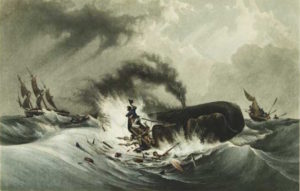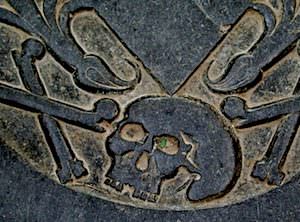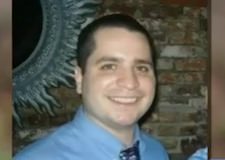Chaco Canyon, Chaco Earth
In New Mexico, a great civilization built a complex religious and administrative center that now lies in ruins. The ghosts there are whispering a message to us: Adapt to a changing world or die. Mr. Fish / Truthdig
Mr. Fish / Truthdig
CHACO CULTURE NATIONAL HISTORICAL PARK, N.M.—A bitter wind whipped down the 10-mile-long Chaco Canyon, kicking up swirls of dust among the thorny greasewood and sagebrush bushes. I ducked behind one of the towering sandstone walls in the three-acre ruin, or Great House, known as Pueblo Bonito, to escape the gusts. I was in the section of the 800-room complex where burials took place. Treasure hunters and archaeologists have uncovered in these ruins and tombs delicate white-and-black painted ceramics, flutes, ceremonial sticks, tiny copper bells, inlaid bone, macaw and parrot skeletons, cylindrical jars with the residue of chocolate that would have been imported from Mexico, shells and intricate turquoise jewelry and sculptures. From this vast, bureaucratic and ceremonial complex, the Anasazi—a Navajo word meaning ancient ones or possibly ancient enemies—dominated the Southwest from about the year 850 until the society collapsed in about 1150.
The Chaco ruin, 6,200 feet above sea level, is one of the largest and most spectacular archeological sites in North America. It is an impressive array of 15 interconnected complexes, each of which once had four-to-five-story stone buildings with hundreds of rooms each. Seven-hundred-pound wooden beams, many 16 feet long, were used in the roofs. Huge circular, ceremonial kivas—religious centers dug into the earth, with low masonry benches around the base of the room to accommodate hundreds of worshippers—dot the ruins. It rivals the temples and places built by the Aztecs and the Mayans.
Radiating from Chaco is a massive 400-mile network of roads, some 30 feet wide and still visible in the haunting desert landscape, along with dams, canals and reservoirs to collect and store rainwater. The study of astronomy, as with the Aztec and the Maya, was advanced. Petroglyphs and pictographs on the canyon walls often record astrological and solar events. One pictograph shows a hand, a crescent moon and a 10-pointed star that is believed to depict a 1054 supernova, and one of the petroglyphs appears to represent a solar eclipse that occurred in 1097.
A few thousand priests and ruling elites, along their retainers and administrators, lived in the Great Houses or palaces. They oversaw the trade routes that stretched to the California coast and into Central America. They maintained the elaborate network of lighthouses whose signal fires provided rapid communication. They built the roads, the long flights of stairs carved into the rock formations, the bridges, the wooden ladders to scale the towering cliffs, and the astronomical observatories that meticulously charted the solar observations to determine the equinoxes and solstices for planting and harvesting and for the annual religious festivals when thousands, perhaps tens of thousands, would gather. The buildings in the complexes were oriented to solstitial or cardinal points, a difference the anthropologist Stephen H. Lekson believes denoted not only competing cosmologies but competing political ideologies.
“Chaco was the political capital of a well-defined region that encompassed most of the Four Corners country, with more than 150 outlying Great Houses scattered over an area about the size of Ireland,” Lekson writes.
But this complex society, like all complex societies, proved fragile and impermanent. It fell into precipitous decline after nearly three centuries. The dense forests of oak, piñon and ponderosa pines and juniper that surrounded the canyon were razed for construction and fuel. The soil eroded. Game was hunted to near-extinction. The diet shifted in the final years from deer and turkey to rabbits and finally mice. Headless mice in the late period have been found by archaeologists in human coprolites—preserved dry feces. The Anasazi’s open society, one where violence was apparently rare, where the people moved unhindered over the network of well-maintained roads, where warfare was apparently absent, where the houses of the rich and powerful were not walled off, where the population shared in the spoils of empire, was replaced with the equivalent of gated, fortified compounds for the elites and misery, hunger, insecurity and tyranny for the commoners. Dwellings began to be built in the cliffs, along with hilltop fortresses, although these residences were not close to the fields and water supply. Defensive walls were constructed along with moats and towers. The large, public religious ceremonies that once united the culture and gave it cohesion fractured, and tiny, warring religious cults took over, the archaeologist Lynne Sebastian notes.
Lekson, a professor of anthropology at the University of Colorado in Boulder, believes the Anasazi rulers during the decline increasingly resorted to savage violence and terror, including the public executions of dissidents and rebels. He finds evidence, much of it documented in Steven A. LeBlanc’s book “Prehistoric Warfare in the American Southwest,” that “Chaco death squads” were sent out across the empire. LeBlanc writes that at Yucca House, a Chaco Great House near Mesa Verde, as many as 90 people were killed and tossed into a kiva and at least 25 showed signs of mutilation.
“Chacoan violence, concentrated and brutal, appears to represent government terror: the enforcement of Chaco’s rule by institutionalized force,” Lekson writes in the article “Chaco Death Squads” in Archeology magazine. “Violence was public, intended to appall and subdue the populace. Chacoan death squads (my term, not LeBlanc’s) executed and mutilated those judged to be threats to Chacoan power, those who broke the rules.”
The anthropologist Christy G. Turner, who specialized in osteology, the study of human bones, in his book “Man Corn” cited “cannibalism and human sacrifice as conspicuous elements of terrorism.” In short, as Lekson writes, “the death squad killed you, cut you up, and then ate you in front of your relatives and neighbors.” The term “man corn” comes from the Nahuatl word “tlacatlaolli,” which Turner defined as a “sacred meal of sacrificed human meat, cooked with corn.” Debra Martin goes on to argue in a paper titled “Violence Against Women in the La Plata River Valley, A.D. 1000-1300” (located on the periphery of the Chacoan empire) that there is evidence of battered women who were perhaps slaves.
The Anasazi elites, no longer willing or able to provide social services or competent governance and plagued by shortages of natural resources, kept extracting unsustainable tribute. They resorted to harsher and harsher forms of repression. By the end, they were hated. The civilization suffered a severe drought in the year 1130. It was the final blow. The impressive structures would lie abandoned until they were discovered by the nomadic Navajos some 600 years later. The Navajos did not reoccupy the buildings, many of which contained skeletal remains, because they believed them to be filled with evil spirits.
“Parts of Chacoan society were already in deep trouble after 1050 as health and living conditions progressively eroded in the southern districts’ open farming communities,” David E. Stuart writes in his book “Anasazi America.” “The small farmers in the south had first created reliable surpluses to be stored in the great houses. Ultimately, it was the increasingly terrible living conditions of those farmers, the people who grew the corn, that had made Chacoan society so fatally vulnerable. The farmers simply got too little back from their efforts to carry on. Thus, great-house society emphasized other trade partners and supported new, lower-cost suppliers on its northern tier. This final trade network likely was focused on the continued well-being of the elites rather than the general welfare of its regional society.”
As the economic and social situation deteriorated, the elites accelerated the building of roads and Great Houses. They held more elaborate rituals and built more kivas. This is typical of decaying societies. The great Mayan city of Tikal was constructed over a period of 1,500 years, but its most impressive temples and towers were erected during its final century. These grandiose projects and spectacles were meant to project power and immortality. They exacerbated, however, the suffering of the impoverished farmers and workers and the decline of diminishing natural resources.
“At the bitter end of the Chacoan era, many elites remained in their great houses, probably trying to hold on to the past, rather like Scarlett O’Hara trying to hold on to Tara in Gone with the Wind,” Stuart writes. “But the farmers who had brought in the corn harvests were long departed, like the slaves who had supported Tara before the Civil War. Chacoan society collapsed, the framing pillar of its once great productivity shattered. The beleaguered Chacoan farmers had buried their babies one last time. Then they abandoned Chaco Canyon and most of its outlying great houses.”
“Prosperity, social integration, altruism, and generosity go hand-in-hand,” Stuart adds. “Poverty, social conflict, judgmental cynicism, and savagery do, too.”
Collapse, as Joseph A. Tainter points out, is “a recurrent feature of human societies.” Complex societies create centralized bureaucratic structures that exploit resources until exhaustion and then prove unable to adapt to scarcity. They create more sophisticated mechanisms to extract depleted resources, evidenced in our own time by the decision of the Trump administration to open up the lands around the Chaco Culture National Historical Park to fracking. In the end, the technologies and organization that make the rise of complex societies possible become the mechanisms that destroy them.
The fate of the Anasazi replicates the fate of all complex societies. The collapse came within one or two decades after the peak. As Jared Diamond writes in “Collapse: How Societies Choose to Fail or Succeed,” the trajectories of complex societies “are unlike the usual course of individual human lives, which decline in a prolonged senescence. The reason is simple: maximum population, wealth, resource consumption, and waste production mean maximum environmental impact, approaching the limit where impact outstrips resources.”
“Civilization is an experiment, a very recent way of life in the human career, and it has a habit of walking into what I am calling progress traps,” Ronald Wright writes in “A Short History of Progress.” “A small village on good land beside a river is a good idea; but when the village grows into a city and paves over the good land, it becomes a bad idea. While prevention might have been easy, a cure may be impossible: a city isn’t easily moved. This human inability to foresee—or watch for—long-range consequences may be inherent to our kind, shaped by millions of years when we lived hand to mouth by hunting and gathering. It may also be little more than a mix of inertia, greed, and foolishness encouraged by the shape of the social pyramid. The concentration of power at the top of large-scale societies gives the elite a vested interest in the status quo; they continue to prosper in darkening times long after the environment and general population begin to suffer.”
We in 2018 are beset with signs of impending collapse. The droughts, wildfires, flooding, soaring temperatures, crop failures, poisoning of the soil, air and water, and social breakdown from global warming are leaving huge segments of the world’s poor without adequate food, water and security. Desperate migrants are fleeing the global south. Crisis cults carry out nihilistic acts of terrorism, often in the name of religious beliefs. Our predatory elites, who have retreated to their own versions of Anasazi Great Houses, with access to private security, private education, private medicine, private transportation, private sources of water and food and luxury items that are unavailable to the wider population, have walled out reality. Their hubris and myopia, as well as blind obedience to an ideology—global capitalism—that benefits them but accelerates social and environmental destruction, mean they have only bought a little more time before they succumb like the rest of us.
The poet V. B. Price, surveying the Chaco ruins in his poem “Time’s Common Sense,” understands the urgent message these stones impart. He writes, in part:
At Chaco I know I am not alone I know I have heard even Homer Weaving the tides of his stories, And Sappho singing lullabies alone in the night, Heard the footdrums in Rinconada Like ancient surf through the stone.
This is the place Where the past remains. Utterly changed, the landscape is the same.
The future happens so fast, It’s too fast to dread. And now the future is as good as already over again.
There is one crucial difference between the Anasazi and our complex society. The collapse of past civilizations like the Anasazi’s was localized. There were always new lands to conquer, new natural resources to plunder and new peoples to subjugate. Our age is different. There is no new world left.
We can no longer live on the capital of the natural world and instead must learn to make do with the interest. This means the end to reliance on fossil fuels and the animal agriculture industry. It means adopting a simplicity that rejects the ethos of capitalism and the hedonism and gluttony that define the consumer society. It means a communal society in which inequality and income disparity are not extreme. If we continue to live as if the future does not matter, our society, like that of the Anasazi, will fracture and die. We will vanish from the earth in an act of global suicide.
The human species faces its greatest existential crisis. Yet, our elites replicate the imbecility, arrogance and greed of past elites. They hoard wealth. They shut us out from circles of power. They use brutal forms of repression to maintain control. They exhaust and poison the ecosystem. The longer the corporate elites rule, the longer we fail to revolt, the less chance we have to endure as a species. Settled or civilized life is less than 10,000 years old. Our peculiar human social construction is but a nanosecond to the universe. It may prove to be a brief and fatal experiment. Perhaps, as Franz Kafka wrote, “There is hope; though not for us.”
Your support matters…Independent journalism is under threat and overshadowed by heavily funded mainstream media.
You can help level the playing field. Become a member.
Your tax-deductible contribution keeps us digging beneath the headlines to give you thought-provoking, investigative reporting and analysis that unearths what's really happening- without compromise.
Give today to support our courageous, independent journalists.



You need to be a supporter to comment.
There are currently no responses to this article.
Be the first to respond.